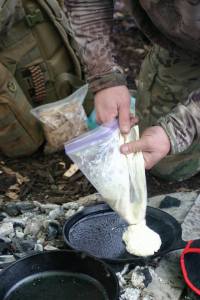I have always said that survival and bushcraft helps to make our brains better. It offers problem solving, creativity, the creation of new neural pathways, and building of social skills. The human brain is fascinating and even as we get older we still need to keep exercising our brains. Building and expanding the super hiways of knowledge and skill not only keeps life more interesting, but can actually reduce the onset of age related disease such as Alzheimer’s
This morning I found this great article and it happens to be from my Emergenetics instructor, Dr. Geil Browning, who is also the co-creater of Emergenetics. Please take a look at the article later, in the mean time I thought I would expand on her viewpoints into our world of survival and bushcraft.
Below I have used Geil’s ideas for building your intelligence and converted them into how survival and bushcraft training can work as an activity base to build better intelligence.
Seek Novelty
While some programming of our body is “hard wired” into us at birth through DNA, we also create new neural pathways every time we experience something new and different.
Survival and bushcraft training place you in a novel experience from the start. In my early studies with Dr. Jon Johnson of Team Leadership Results, he focused on how new and novel experiences are a platform for creating the experiential learning environment. Setting up a shelter in the woods, starting fires with new methods, and simplifying your gear to 8-12 items for a weekend hike are all part of a new experience. Taking a class in firecraft, wild edibles, or even 18th century sewing are examples of new experiences that will help build new neural pathways.
Challenge Yourself
When asked, most of us would agree that its’ life’s experiences that teach us the most. We need to learn new things every day of our life just to sustain ourselves.
The pathway along which information travels through the neurons of the brain is a neural pathway. A neural pathway created through life’s experiences. Imagine you lived in the woods and you had to walk from your cabin to a near by stream, but there isn’t a path. As you meander through the woods to the stream each day you begin to form a small path. Pretty soon, the path is wide enough you can ride a bike for faster access. Not only have you built the pathway, you have created a mini-highway to travel on. You know it so well you could navigate it without thinking about it. The only way to make it more challenging is to do it at night, or in the snow, or even walking backwards.
Once you have acquired skills such as making fire, navigating using a map and compass, or purifying water by boiling it, you need to continue to not only practice to master, but rather challenge yourself through the use of different methods, tools, environmental challenges or by handicapping. I make on average 5-7 fires a week using various methods, none of which include matches or lighters. When I fell down the stairs a few months ago and had my arm in a sling, I challenged myself to build fires using only one hand, and at that, my weak hand to produce fire. To challenge your own fire skills you don’t need to launch headfirst into a wall, but you can try to create fire in the rain (or turned on sprinkler system), purify water without your normal kit, or navigate in the dark.
Think Creatively
Survival and bushcraft training builds your problem solving and creativity skills better than many other methodologies. The more opportunities we have to solve basic issues in the outdoors and experiences we endure, the more we learn and grow. For the most part these experiences are a benefit even if we fail and don’t feel we had a successful or positive experience.
Some of the best experiences I have had is when things were not going as panned and I had to think of new options. In 2003 I lost all my water while on a trip into Big Bend National Park. I had to find creative ways to make shade during the day so I could hold up when temps were soaring, find or extract water from plants and rock crevices, and navigate at night when it was cooler.
Another way to push creativity is by making your own gear. Anoraks, sheaths, and ditty bags are just of the few items you can start with to push your own creative skills.
Do Things the Hard Way
I get harassed allot for not using matches and lighters and that gasoline and flares make fire faster. But pushing myself to make fire by friction grows new pathways in my brain. I would take this one a bit further though and say to learn to endure discomfort as well. Having solid skills is one thing, applying those skills when the conditions are challenging are a step better.

Networking
On the surface we think of survival and bushcraft training as a solo endeavor. There is a whole network of people just like you who want to increase their skill level. Working through simulated problems, learning together, and even challenging each other builds strong friendships.
Here is a link to the original article by Dr. Browning:














